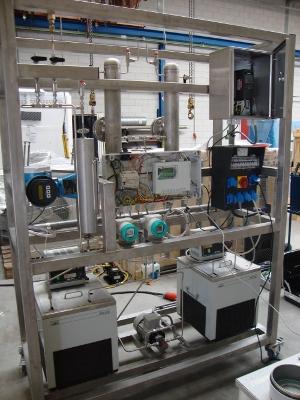CO2 hydrate slurry production
CO2 hydrates are formed from two-phase systems by contacting the CO2 gas with liquid water and increasing the pressure until crystalline hydrate forms.
The experimental set-up is composed of stainless steel pipes with an inner diameter of 6 mm and 1 mm wall thickness. The system consists of two thermostatic baths and two coil heat exchangers, a gear pump and two buffer vessels.
The water-CO2 hydrate mixture is cooled in one coil heat exchanger using a thermostatic bath filled with water-ethanol mixture. The effective cooling capacity is 0.3 kW. Two vessels with the volume of 3 L are used in order to separate the hydrate slurry from the excess CO2 gas. They are equipped with pressure safety valves of 40 bar. Stainless steel sight glasses are installed in the hydrate flow and in each vessel. The hydrates are dissociated in the second thermostatic bath filled with water that has a maximum heating power of 2 kW. The flow is circulated with a gear pump with adjustable speed that can deliver a flow up to 170 dm3/h.
The temperature and pressure is measured before and after the hydrate formation in the thermostatic bath with PT100 sensors and pressure transmitters. The experimental set-up also includes a Coriolis flow meter which is used to measure the density of the produced slurry. The measured pressures, temperatures and densities are stored by a data logger.
The experiments are performed by cooling a saturated mixture of water and CO2 at temperatures between 4 and 8ËšC under hydrate forming conditions (10 to 40 bar) in order to identify the phenomena taking place during hydrate formation.
Related projects
This is part of the “Koudegroep Delft/Wageningen” project Pumpable Hydrate Slurries for Air Conditioning / Refrigeration Applications, realized with support and direct involvement of industrial partners Grolleman Coldstore, Lunenburg, Sparkling Projects and IBK Groep.
